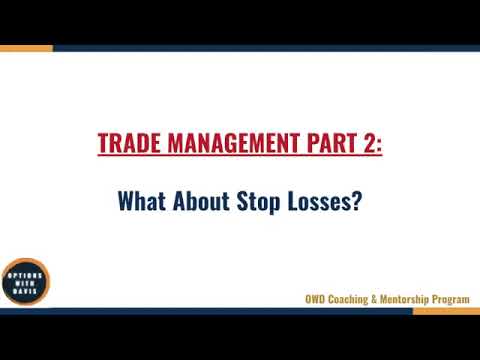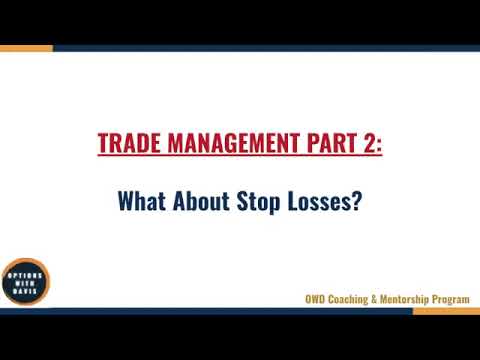In the second part of the Trade Management video, we’re diving into the effectiveness of using stop losses in options trading. While stop losses are commonly used in traditional stock trading, the results may not be as favorable when it comes to options. Tasty Trade conducted studies on stop losses and found that holding trades until expiration actually performed better than managing losers with a stop loss. This is because options have Theta Decay, which allows for profit potential even if the trade initially shows a loss. Additionally, spreads, which already have built-in risk limitations, eliminate the need for an additional stop loss. Therefore, it is recommended to exit positions at 21 days-to-expiration (DTE) or when the trade reaches its maximum loss or buying power reduction (BPR) to effectively manage risk, without the need for stop losses.

The Importance of Exit Strategies
As an options trader, it is crucial to have effective exit strategies in place to manage risk and maximize profits. One popular exit strategy is to exit a trade at 21 days-to-expiration (DTE). This approach has been found to yield superior performance and better risk control compared to holding a trade until expiration.
Exiting at 21 DTE allows traders to maintain better control over their trades. By exiting at this predetermined time, you can avoid the potential negative impacts of market volatility as expiration approaches. It also allows you to take advantage of the benefits of Theta Decay, which is the gradual decrease in the value of options over time.
Comparatively, holding a trade until expiration can be risky. The value of options can be unpredictable as expiration nears, and sudden market movements can lead to significant losses. By implementing an exit strategy at 21 DTE, you can mitigate these risks and secure more consistent profits.
The Effectiveness of Stop Losses in Options Trading
Stop losses are a commonly used tool in the world of stock trading, where they help manage risk and prevent significant losses. However, their effectiveness in options trading is a subject of debate. Many traders wonder if implementing stop losses in options trading is an effective risk management strategy.
Tasty Trade, a renowned options trading platform, conducted studies on stop losses to evaluate their effectiveness. The results showed that holding a trade until expiration actually outperformed the strategy of managing losers with a stop loss. This finding suggests that stop losses may not be as effective in options trading as they are in stock trading.
Comparing Holding to Expiration vs. Stop Losses
To further explore the effectiveness of exit strategies, Tasty Trade studied the performance of the 16 Delta strangle and short put options. The 16 Delta strangle is a strategy that involves simultaneously selling a slightly out-of-the-money call option and a slightly out-of-the-money put option. The short put strategy, on the other hand, involves selling a put option with the aim of profiting from premium decay and limited upward movement of the underlying asset.
The results of the study indicated that holding these options until expiration yielded better results compared to using a stop loss strategy. The graphs presented in the study clearly showed that exiting at 21 DTE consistently outperformed both holding to expiration and implementing a stop loss.
One of the key factors contributing to the superior performance of holding to expiration is Theta Decay. Options have Theta, which represents the rate of time decay of their value. Over time, as the expiration date approaches, the value of options decreases, allowing traders to still realize profits even if the trade initially shows a loss. By holding to expiration, traders can benefit from Theta Decay and exceed their profit potential.
Missed Opportunities with Stop Loss
One potential downside of using a stop loss strategy is the possibility of prematurely exiting a trade before it reaches its profit potential. Stop losses are often set at a specific price level, triggering an automatic exit when that level is reached. However, in the context of options trading, this can result in missed opportunities for profit.
Let’s consider a scenario where you have a stop loss of $500 for a short put trade. If the market suddenly drops significantly and reaches a price that triggers your stop loss, you would be forced to exit the trade at a loss. However, if you had held onto the trade, you may have experienced a turnaround in the market, allowing you to still achieve a profitable outcome.
Options trading is unique because of its Theta Decay feature. This means that even if a trade initially shows a loss, there is still the potential for the value of the options to increase over time. By using a stop loss, you may cut yourself off from these potential opportunities and limit your overall profit potential.
Risk Limitations of Spreads
Spreads, such as credit spreads and debit spreads, offer built-in risk limitations that eliminate the need for an additional stop loss strategy. In a spread, you simultaneously buy and sell options to create a position with a limited risk and reward structure.
The main advantage of spreads is that the maximum loss is predefined and limited. When entering a spread trade, traders know exactly how much they stand to lose if the trade goes against them. This eliminates the need for a stop loss, as the predefined risk limitation acts as a natural exit point for the trade.
By using spreads, traders can effectively manage risk without relying on stop losses. This strategy allows for greater peace of mind and eliminates the potential stress of closely monitoring price levels and executing stop orders.
Recommended Exit Strategies in Options Trading
Based on the research and studies conducted, it is recommended to exit options positions at 21 DTE or when the trade reaches its maximum loss or buying power reduction (BPR), especially for undefined risk trades. These exit strategies provide effective risk management and take advantage of the benefits of Theta Decay.
Exiting at 21 DTE allows traders to maintain better control over their trades and avoid potential losses due to market volatility. It maximizes the potential for profits by taking advantage of Theta Decay. By exiting at this predetermined time, traders can secure more consistent profits and mitigate risks associated with holding a trade until expiration.
For trades with predefined risk limitations, such as spreads, there is no need for an additional stop-loss strategy. The predefined risk limitation of spreads acts as a natural exit point, ensuring that losses are limited and manageable.
In conclusion, effective exit strategies are essential in options trading for risk management and maximizing profits. Implementing stop losses in options trading may not be as effective as it is in stock trading. Instead, exiting at 21 DTE or when the trade reaches its maximum loss or BPR is recommended for better risk control and overall performance. Understanding the unique aspects of options, such as Theta Decay, is crucial in developing successful exit strategies.
